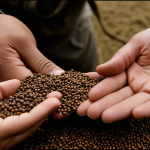Essential Ingredients for a Genuine Cornish Pasty
Crafting an authentic Cornish pasty relies heavily on selecting the right ingredients. Traditional fillings include a mix of meat, potatoes, onions, and swede. Each component plays a vital role in achieving the pasty’s renowned taste and texture. Meat often forms the core of this ensemble, traditionally using beef; however, other meats can also be incorporated based on personal or regional preferences.
It’s essential to choose quality ingredients to ensure authenticity. Fresh, locally-sourced produce enhances flavours significantly, maintaining the pasty’s traditional character. While variations do exist, especially with regions adding their personal touches, the classic mix remains the benchmark of genuine Cornish pasty ingredients.
Have you seen this : Crafting a luxuriously flavorful mushroom risotto with white wine: a step-by-step guide
Although subtle differences emerge in various locales, such as the kind of potatoes or the cut of meat used, the fundamental components shouldn’t be overlooked. This ensures the pasty retains its distinct identity, which has been cherished through generations. Emphasizing the importance of ingredient quality highlights the pasty’s heritage and sustains its cultural legacy.
Authentic Pastry Preparation
Before delving into the creation of a truly authentic Cornish pasty, it’s crucial to focus on the pastry components that encapsulate the filling. The use of Cornish pasty dough plays a significant role in preserving the traditional texture and taste. Choosing the right flour is essential; plain flour offers the perfect balance, ensuring a robust yet tender pastry. Complement this with high-quality butter, as it significantly influences the dough’s flavour and flakiness.
In parallel : Savor a decadent dark chocolate soufflé with a surprising spicy twist!
Creating the ideal dough involves precise measurements and technique. Start by combining flour and butter, lightly rubbing them together until the mixture resembles breadcrumbs. Add a touch of water, carefully mixing until a cohesive dough forms. Expertly rolling the pastry technique involves maintaining an even thickness throughout, usually around 5mm. This ensures uniform cooking.
Rolling pastry to the right thickness is crucial as it affects both the pasty’s structure and insulation of the fillings. Shape the dough into rounds appropriate for enclosing your chosen ingredients. Perfecting these techniques will allow you to create a pasty that reflects the heritage of authentic Cornish pasty preparation, sustaining a cherished culinary legacy.
Traditional Cooking Techniques
When mastering the art of baking Cornish pasty, traditional cooking methods are your guide. Understanding the precise oven temperature is crucial. To ensure the pasty develops its distinctive golden crust while baking evenly, preheat the oven to 220°C (428°F). This initial high temperature helps set the pastry, locking in precious moisture.
Preparing the Filling
Begin by assembling the essential Cornish pasty ingredients: diced meat, potatoes, onions, and swede. These must be finely sliced to ensure even cooking. Each component should be raw when placed in the pastry. This allows them to meld together during baking, creating the pasty’s characteristic robust flavour.
Sealing the Pasty
Correct sealing is vital to preserve flavour and moisture. Lay your pastry rounds on a clean surface and spoon filling onto one side. Fold the dough over and crimp the edges. This involves pinching or using a technique like rolling to secure the seam, a hallmark of an authentic Cornish pasty.
Baking Guidelines
Reduce the oven to 180°C (356°F) after 10 minutes of baking. Continue for an additional 40-50 minutes until a deep brown colour is achieved. Following these cooking methods guarantees that the pasty will be filled with flavourful juices, offering an impeccable authentic Cornish pasty experience.
Historical Context of the Cornish Pasty
The Cornish pasty’s history is as rich as its flavour, with roots dating back to the 13th century. Originally a practical meal for miners and farmworkers, its cultural significance is profound in Cornwall. Traditionally, the pasty was a worker’s staple because its dense crust acted as an effective handle, allowing laborers to eat without contaminating their food with dirt from their hands.
Over time, the Cornish pasty has retained its core essence, despite subtle evolutions in filling and technique. These adaptations illustrate the pasty’s resilience, reflecting the changes in regional tastes and ingredient availability while honouring its traditional practices. Special events and celebrations often feature pasties as a nod to cultural heritage, underlining their integral role in local customs.
Although its form has slightly transformed, the authentic Cornish pasty remains a celebrated icon—bridging its historic origins with contemporary culinary expectations. Today, the pasty is not only a savoury dish but also a symbol of Cornish identity, affectionately reinforcing communal ties and historical pride, wherever it is enjoyed.
Troubleshooting Common Issues
Crafting the perfect authentic Cornish pasty can present certain challenges. Common issues encountered often stem from leaky pastry, uneven baking, or fillings not cooking through. To mitigate these, ensure precise ingredient measurements and adherence to Cornish pasty recipes.
For leaky pastries, it is crucial to crimp edges properly. This can be done by pressing firmly yet gently, securing the seam to lock in juices. If pastries bake unevenly, verify oven temperature and placement. A pre-heated oven at the correct temperature range ensures consistent cooking. Use baking sheets at the center rack for balanced heat distribution.
Adjustments in cooking methods may be necessary depending on your oven type. Convection ovens often require a slight temperature reduction, as their fan systems provide even air circulation. Monitoring progress during baking helps make timely changes for the desired result.
To achieve the perfect texture, balance moisture in the fillings. Ingredients like onions and swede add moisture, which complements the robust filling structure. Paying attention to these details ensures your homemade Cornish pasty triumphantly embodies traditional taste and authenticity.
Serving Suggestions and Pairings
The Cornish pasty shines as a versatile dish, and its enjoyment is enhanced with suitable accompaniments. Traditionally, Cornish pasty serving options include simple sides like pickles, mustard, or a light salad, enhancing the savoury experience without overwhelming it. These classic choices complement the hearty fillings with refreshing contrast.
When it comes to beverages, opt for pairings that harmonize with the pasty’s robust flavours. A crisp, dry cider or a well-rounded ale often makes the perfect accompaniment, enhancing the Cornish pasty’s hearty and savoury notes. Alternatively, a light-bodied white wine or even a cup of traditional Cornish tea offers a delightful contrast.
For those seeking creative serving ideas, consider using the pasty as a unique centerpiece for gatherings. Miniature pasties are perfect for parties, providing a bite-sized taste of tradition. Pairing recommendations also extend to chutneys or relishes, adding a splash of colour and complexity to each plate.
These suggestions not only elevate the pasty experience but can transform a simple meal into a vibrant occasion, infusing tradition with contemporary flair while celebrating the authentic Cornish pasty heritage.
Visual Components and Recipe Variations
In the culinary world, Cornish pasty variations provide a canvas for creativity while preserving tradition. These variations range from size, shape, to filling, reflecting personal or regional preference. Classic styles are U-shaped with crimped edges, yet some modern versions experiment with half-moon shapes and intricate crimping designs.
Visual step-by-step guides enhance understanding, ideal for home bakers perfecting their technique. Illustrations detailing each phase—from combining pastry components to sealing the pasty—equip you to replicate authentic results. These visuals ensure even novices can achieve the ideal Cornish pasty dough consistency and crimping style.
Exploring contemporary adaptations allows traditional recipes to evolve. Pasty styles incorporating different meats or vegetarian substitutes cater to diverse dietary needs. Modern twists include adding cheeses or spice blends to the filling, offering a fresh perspective while respecting cultural heritage.
Whether you adhere to time-honoured methods or experiment with new ingredients, maintaining the essential pasty elements—flaky pastry, balanced fillings, and meticulous preparation—results in a delicious homage to the authentic Cornish pasty. The potential for personalization makes the pasty a versatile dish, celebrating both tradition and innovation in its various forms.



